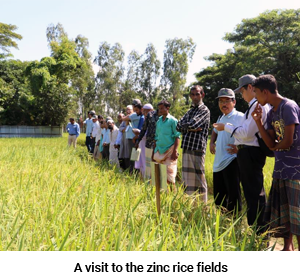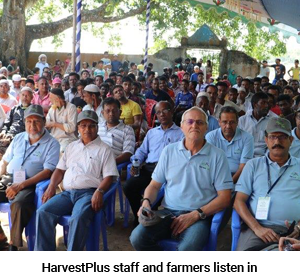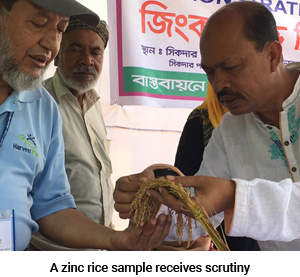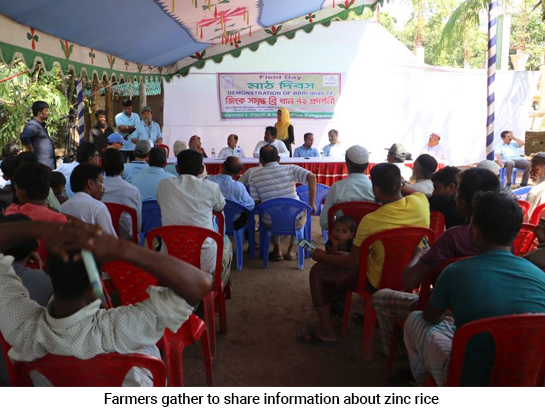We heard a booming loudspeaker in the distance as we walked down a narrow road through rice fields and rustic dwellings in a rural district near the southern seaside town of Cox’s Bazar. We were with the HarvestPlus Bangladesh team on our way to attend a meeting with small farmers, several of whom had planted demonstration plots of zinc-biorfortified rice varieties that HarvestPlus had distributed in the district.
The meeting was under way in a dirt courtyard with a large, colorful tapestry suspended overhead to provide shade from the midday sun for several dozen farmers in attendance and for the guest speakers. The purpose of the early November gathering was to find out about the participating farmers’ experiences with the zinc rice varieties so far and encourage other farmers to try them.
The speakers included local officials, local farmers, and HarvestPlus staff. Wolfgang Pfeiffer, HarvestPlus’ director of research and development, said, “We have come here to learn from you, to learn about your experiences with yield, growing conditions, and so on.” He spoke in English and a local colleague translated into Bengali. “I’m from Germany, and we are champions in soccer. But in high-zinc rice, Bangladesh is the world champion, the first country in the world that started using it. We want to know what you think!”
Zinc-biofortified varieties of rice and other crops are produced by HarvestPlus and its crop breeding partners to address a widespread nutritional deficiency that impedes normal human growth and development. Lack of dietary zinc in young children can contribute to stunting, diarrhea, pneumonia, and other childhood infections, and it can negatively impact women and fetuses during pregnancy. Biofortification is not the only method of improving zinc intake but it is particularly useful for targeting low-income and subsistence farming families who may lack diversified diets and/or ready access to commercially available fortified foods or supplements.
The first zinc rice varieties developed by HarvestPlus were released in Bangladesh in 2013, and in the first year, the country program reached 1,000 farming households cultivating approximately 202 hectares of land. Expansion has been brisk since then: the latest figures show HarvestPlus Bangladesh has distributed biofortified seed to over 630,000 farming households with roughly 120,000 bags of seed distributed annually. The total number of farming households using the seeds is actually about 1.5 million because many direct recipients of the seeds pass some along to other farmers.
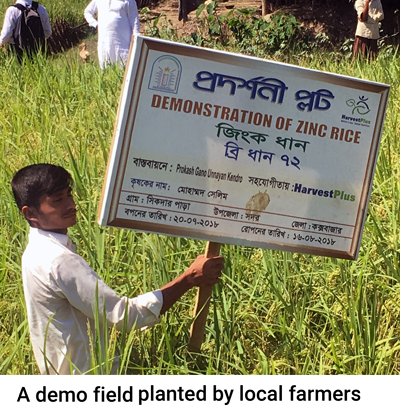 The distribution effort in a particular area often begins with the establishment of demonstration plots on land of farmers who are selected in consultation with nongovernmental organizations, agricultural extension officials, and local authorities or influencers. So far, over 14,000 demo plots have been established around Bangladesh (the photo to the left shows a sign in a demo plot in the area we visited, identifying the zinc rice variety planted there). Demo plots are the forward wedge in the drive to educate and engage farming communities in the use of biofortified crops and adapt cultivation practices to local conditions.
The distribution effort in a particular area often begins with the establishment of demonstration plots on land of farmers who are selected in consultation with nongovernmental organizations, agricultural extension officials, and local authorities or influencers. So far, over 14,000 demo plots have been established around Bangladesh (the photo to the left shows a sign in a demo plot in the area we visited, identifying the zinc rice variety planted there). Demo plots are the forward wedge in the drive to educate and engage farming communities in the use of biofortified crops and adapt cultivation practices to local conditions.
The day before the farmers meeting, Khairul Bashar, the Bangladesh country manager for HarvestPlus, gave a presentation at a biofortification workshop at a Cox’s Bazar hotel in which he noted that about 4 in 10 children under age five in the country do not get enough zinc in their diet. He also cited a survey of girls ages 15-19 conducted by the World Health Organization in 2013 showing that 44 percent of them were stunted for their age due to nutritional deficits early in life. These and other statistics make a strong case for zinc biofortification. Indeed, Bangladesh is a promising country for such an investment, according to the results of HarvestPlus’ biofortification prioritization index, which ranks countries on their propensity to benefit from a particular crop enrichment method.
While the health argument is a strong one and the nutritional need exists, getting farmers to adopt biofortified crops and thereby reap their nutritional benefits takes hard work. Bashar and his colleagues at HarvestPlus in Bangladesh have been to thousands of such “yard meetings” in the five years since zinc rice was first introduced in the country, and they know that the first year of cultivation on demo plots in a new location is a cautious learning process for the farmers. “We are used to getting a mixed reaction because [the farmers] are adapting to a new, unknown variety,” he said.
Farmers meetings and other types of direct, on-the-ground outreach are critical to the process of promoting adoption of zinc rice—a very weighty decision for farming families who depend on their crops for their own sustenance and income. To make the “sale,” HarvestPlus, partnering nongovernmental organizations, and extension agents need to explain some nutrition basics, the role of zinc therein, and why it can make a positive difference in their families’ lives. Equally important, farmers need proof that growing zinc rice won’t add production costs or lead to lower yields in comparison to non-biofortified rice.
At the farmer’s meeting, Bashar told the farmers that consumption of the zinc rice won’t mean lower yields and it “can help make your children healthier, and smarter.” His simple but powerful message seemed to resonate. Bashar first asked how many farmers had cultivated the zinc rice seeds and several hands went up; he then asked how many other farmers were interested in trying the seeds, and many more hands were raised. The process of expanding interest and engagement had begun.
